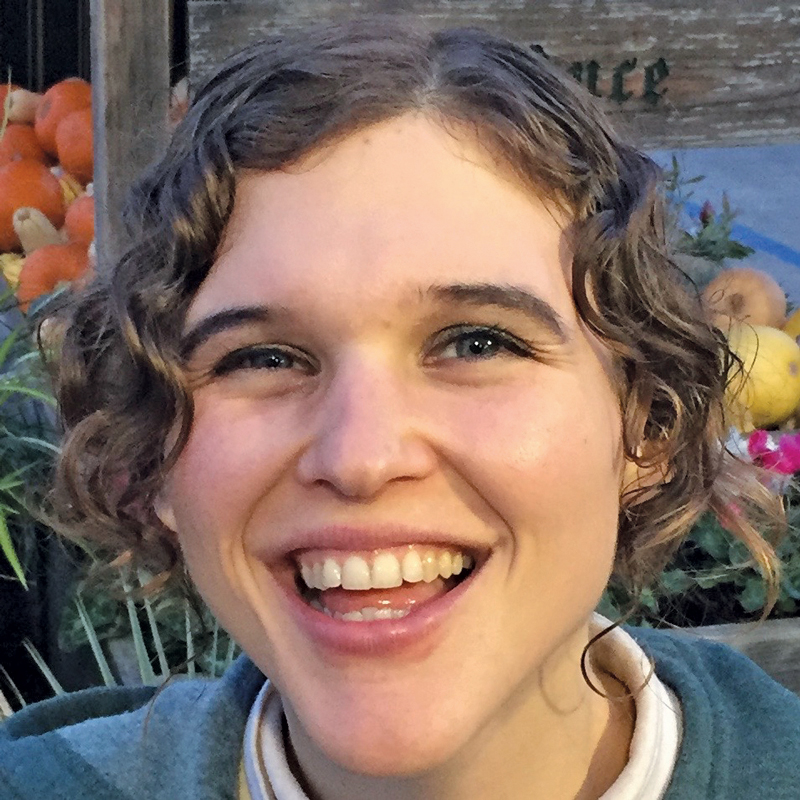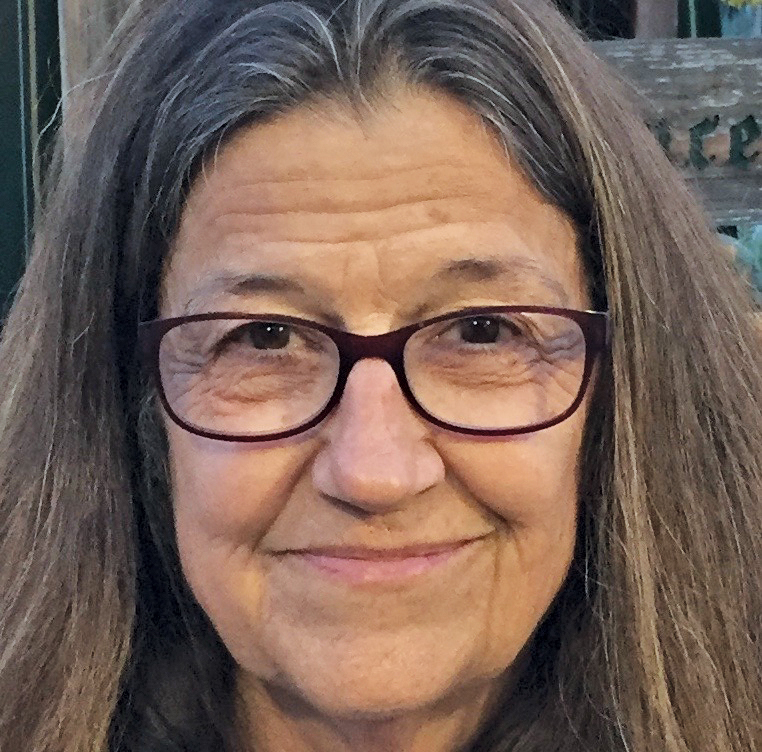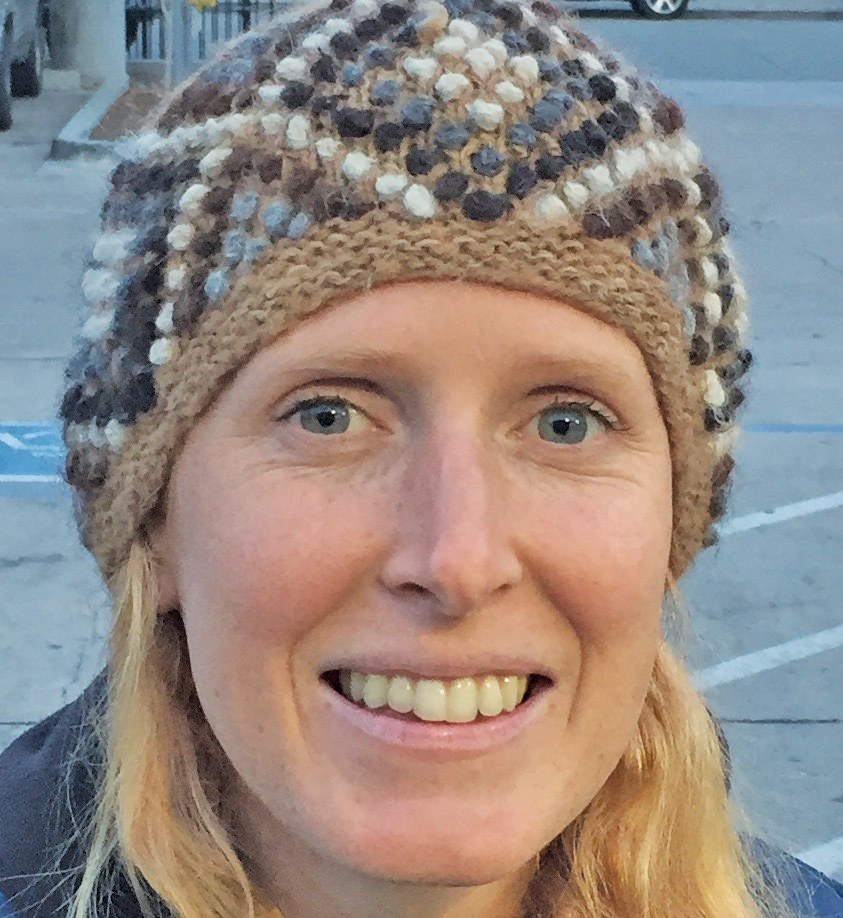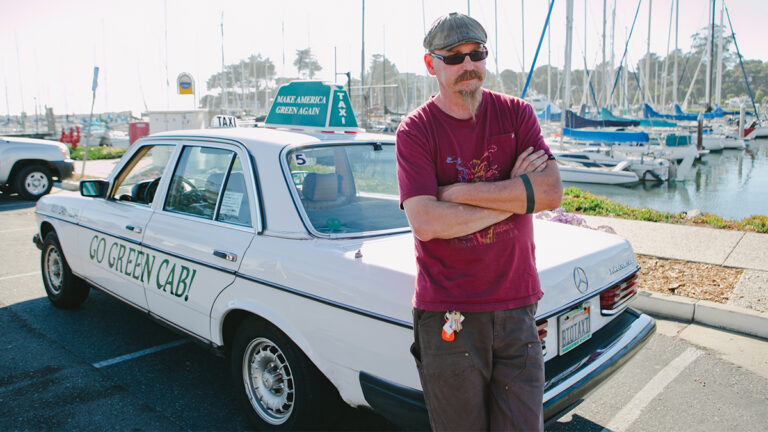Brian Lister hands me two black-and-white bumper stickers that read “Don’t Be a Guber” for a new project he’s starting. But this isn’t a band or an artistic undertaking. The URL at the bottom reads ubersaregubers.com.
Lister is the founder, owner and a driver for Go Green Cab Co., a local, environmentally friendly taxi company. Locals and tourists alike recognize their iconic fleet of white 1980s Mercedes—“I never realized that rhymed,” Lister says with a laugh—that run exclusively on biodiesel made from vegetable oil.
Although it once sounded like the perfect fit for Santa Cruz, the taxi company’s business strategy has encountered potholes since Lister launched more than a decade ago—most recently, the rise of ride-sharing apps like Uber, which have hurt the bottom lines of taxi companies around the globe. For Go Green Cab in particular, the road ahead isn’t getting any smoother as the Green Station, Santa Cruz’s only biodiesel supplier, is shutting down. The station, which rents out U-Haul trucks, has stopped serving biodiesel, and will be closing for good by the end of the year.
The fueling stop on the corner of Ocean Street and Soquel has provided an alternative to petroleum for nine years, but the property owner, Previn Patel, is currently looking for a new tenant in hopes of maybe adding yet another hotel to the tourism-focused Ocean Street strip.
“I don’t know what’s going to happen,” admits Lister, who’s been trying to get in touch with fuel companies directly to buy from them. “I’ve gone around to the gas stations, and nobody really knows who owns what, it seems.”
Lister started Go Green Cab in 2006, after he had already accrued 12 years of taxi-driving experience. Although he loved being a cabby, he felt burdened by the environmental impact of the gas guzzlers, and he came up with the idea for a different business model.
“At that time, Priuses were still new,” he remembers. “However, the Mercedes were a global standard for taxis. They were designed to run for miles and miles.”
He originally planned to produce his own fuel, envisioning a self-sufficient service flowing from production to the customer. Looking back, he says he didn’t consider just how dirty of a process producing biodiesel is. It involves heating and filtering used vegetable oil—often from restaurants—to remove any particles that could potentially damage an engine. Production sites must be big enough to store huge vats and equipment.
“Right when I was figuring it all out, I saw a sign at the gas station on the corner of 7th and Soquel saying ‘Now serving biodiesel,’” remembers Lister. “So I decided to pay them for fuel instead.”
Slowly, Go Green Cab grew to six drivers, and business was still strong in 2009, when he sold the company to one of his employees and decided to finish college in South Carolina, where he remained until returning to Santa Cruz two years ago. To help fund the repurchase of the company and upgrades, he launched a GoFundMe campaign which raised $778, well short of its $15,000 goal.
“Friday and Saturday nights used to be the best for fares, by far,” he says. “Now it’s not even worth it.”
Since bursting on the scene in 2009, Uber has wrecked the taxi industry with its phone app, allowing customers to call for a ride with the push of a button. It helped that the tech company’s prices were much lower. Lister says ride-sharing companies have an additional—and unfair—advantage in that they classify themselves as “transportation network” companies, rather than cab companies which allows them to operate basically without regulation. Taxis, on the other hand, get routinely inspected, and their drivers must be fingerprinted and drug tested regularly.
“We also have to carry 10 times the insurance their drivers do,” he adds.
Meanwhile, the marketplace has grown distorted in ways that probably aren’t sustainable.
While coasting off investor money, Uber is operating at a massive loss. Earlier this year, the company announced losing $708 million in the first quarter, putting it well on its way to matching the 2016 total loss of $2.8 billion, as it competes with app company Lyft, which is also losing money. Although tech companies often operate at a loss before earning billions when they go public, $2.8 billion is a massive number compared, for instance, to Amazon’s $214 million deficit in 2014, its last year of profit loss.
The closure of the Green Station, which hasn’t pumped biodiesel in weeks, poses an additional threat to Go Green Cab. Lister has been getting fuel from out of the county, and sometimes he’s even been filling up with regular diesel when needed.
Even when the Green Station did have biodiesel, customers were paying $3.79 a gallon for biofuel, a full dollar more than regular diesel. Ray Newkirk argues that if it weren’t for government subsidies to traditional diesel and petroleum companies, biofuels wouldn’t look so disproportionately pricey.
“We pay for gas in a lot more ways than just at the pump,” he argues. “If you look at the price of gas in most of the world, they pay a lot more for it, because they are not subsidizing it.”
For the last 18 years, Newkirk, who owns a construction company on the side, has been trying to grease the way for a local biofuel boom. He made his first batch in 1999—“as a renegade,” he says—and opened his first biodiesel business, Pacific Biofuel, in 2003. Three years later, he was already filing for bankruptcy.
“We had bigger appetites than our wallet could supply,” he chuckles.
After a hefty investment in 2008 from customer-turned-business-partner Ed Grace, Newkirk moved the business to its current location, reopening as the Green Station. Along with biodiesel, and renting U-Hauls, the station briefly sold Zenn Cars—electric vehicles that could go about 25 miles on a single charge and sold for relatively affordable prices—to help supplement the business.
Despite patching it together, the Green Station has been running on fumes, and their landlord Patel told them earlier this fall they would need to move.
“I’ve had the property on the market a couple of times, but there have been no buyers in the past,” says Patel. “It’s sad that biodiesel has faded away, but it’s time to try something different.”
Patel, a 30-year Santa Cruz resident, says he has been giving the station the cheapest rent possible because he believes in their service, but he feels the location is too lucrative for him to continue that. Lister believes Patel has been looking for a hotel company to move in—continuing the row of lodging Ocean Street is known for—but Patel says that isn’t necessarily how things will play out.
“I had plans years ago for a hotel to be developed there because it’s zoned for one,” he says “However, Hertz Rental Car is also interested in leasing the property, so we’ll see what happens.”
Since Lister’s “renegade” biofuel days, one energy source has taken off more than anyone could have imagined: electricity. Although biodiesel significantly cuts back emissions compared to gasoline, it isn’t perfect, as it contains higher levels of nitrous oxide, a potent greenhouse gas. Lister says he would be interested in adding electric vehicles into his fleet, but doesn’t believe the current technology fits with his business model. He warns that while it’s advertised as a clean energy source, electricity comes at a cost too.
“Electric vehicles still need to plug into the grid,” says Lister. “Depending where you’re at, that could be nuclear or coal power.”
Newkirk is holding out hope for a biodiesel co-op, much like the BioFuel Oasis in Berkeley, where the responsibilities of running a shop are spread among workers who all have a hand in the business.
“I’ve put my life into it for 18 years now, and I can’t do it anymore,” Newkirk says. “Unfortunately, nobody has stepped up to the plate.”
Update 11/15/17 3:27 p.m.: This story originally gave credit to the wrong author. The byline has been corrected.





























